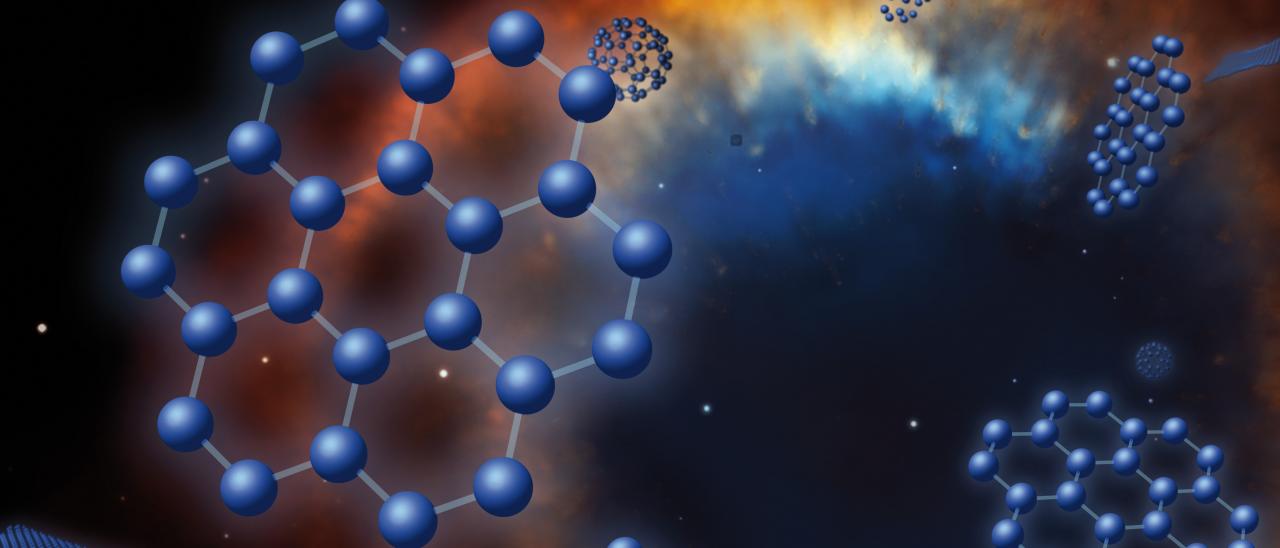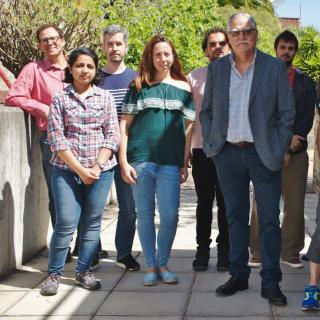Subvenciones relacionadas:
General
Las estrellas de masa baja e intermedia (M < 8 masas solares, Ms) representan la mayoría de estrellas en el Cosmos y terminan sus vidas en la Rama Asintótica de las Gigantes (AGB) - justo antes de formar Nebulosas Planetarias (NPs) - cuando experimentan procesos nucleosintéticos y moleculares complejos. Las estrellas AGB son importantes contribuyentes al enriquecimiento del medio interestelar, donde nacen nuevas estrellas y planetas (incluyendo nuestro propio Sistema Solar Temprano, SST) y a la evolución química de sistemas estelares como cúmulos globulares (CGs) y galaxias. En particular, las AGBs más masivas (M > 4-5 Ms) sintetizan (radio)isótopos muy diferentes de los formados por AGBs menos masivas y explosiones de Supernova debido a los diferentes mecanismos de nucleosíntesis. Las estrellas evolucionadas en la fase de transición entre AGBs y NPs también forman diversos compuestos orgánicos como PAHs y nanoestructuras moleculares de fullereno y grafeno, siendo un maravilloso laboratorio Astroquímico. Colaboraciones astronómicas punteras como SDSS-IV/APOGEE-2 y el próximo telescopio espacial James Webb representan un paso fundamental para entender la nucleosíntesis y los procesos moleculares en estrellas evolucionadas. Se pretende explorar la nucleosíntesis de (radio)isótopos ligeros/pesados en estrellas AGB y como éstas contribuyen a la radioactividad del SST así como a la formación/evolución de CGs y galaxias. También se pretende entender el proceso de formación "top-down" de nanoestructuras moleculares de fullereno y grafeno en estrellas evolucionadas. Finalmente, se pretende realizar minería de datos obtenidos con el satélite Gaia, para estudiar la fase evolutiva AGB-NP, y además utilizar el telescopio espacial GALEX para descubrir estrellas binarias en NPs Galácticas.
Miembros
Resultados
1. Durante 2020, se han publicado 37 artículos en revistas astronómicas internacionales con referee de alto impacto (incluyendo un review invitado), así como 2 artículos en la revista de Química-Física FNCN.
2. Se han descubierto, por primera vez, estrellas muy ricas en fósforo y cuyo patrón químico no es predicho por ninguna teoría actual de nucleosíntesis estelar.
3. Se ha demostrado que las estrellas ricas en fósforo representan un nuevo sitio estelar para la formación de elementos muy pesados, con importantes implicaciones para la evolución química de nuestra Galaxia.
Actividad científica
Publicaciones relacionadas
-
Exploring Anticorrelations and Light Element Variations in Northern Globular Clusters Observed by the APOGEE Survey
We investigate the light-element behavior of red giant stars in northern globular clusters (GCs) observed by the SDSS-III Apache Point Observatory Galactic Evolution Experiment. We derive abundances of 9 elements (Fe, C, N, O, Mg, Al, Si, Ca, and Ti) for 428 red giant stars in 10 GCs. The intrinsic abundance range relative to measurement errors is
Mészáros, Sz. et al.Fecha de publicación:
52015 -
The APOGEE Spectroscopic Survey of Kepler Planet Hosts: Feasibility, Efficiency, and First Results
The Kepler mission has yielded a large number of planet candidates from among the Kepler Objects of Interest (KOIs), but spectroscopic follow-up of these relatively faint stars is a serious bottleneck in confirming and characterizing these systems. We present motivation and survey design for an ongoing project with the Sloan Digital Sky Survey III
Fleming, S. W. et al.Fecha de publicación:
42015 -
Asymptotic giant branch stars in the Large Magellanic Cloud: evolution of dust in circumstellar envelopes
We calculated theoretical evolutionary sequences of asymptotic giant branch (AGB) stars, including the formation and evolution of dust grains in their circumstellar envelopes. By considering stellar populations of the Large Magellanic Cloud (LMC), we calculate synthetic colour-colour and colour-magnitude diagrams, which are compared with those
Dell'Agli, F. et al.Fecha de publicación:
32015 -
A search for diffuse bands in fullerene planetary nebulae: evidence of diffuse circumstellar bands
Large fullerenes and fullerene-based molecules have been proposed as carriers of diffuse interstellar bands (DIBs). The recent detection of the most common fullerenes (C60 and C70) around some planetary nebulae (PNe) now enable us to study the DIBs towards fullerene-rich space environments. We search DIBs in the optical spectra towards three
Díaz-Luis, J. J. et al.Fecha de publicación:
12015 -
Tracking Advanced Planetary Systems (TAPAS) with HARPS-N . I. A multiple planetary system around the red giant star TYC 1422-614-1
Context. Stars that have evolved off the main sequence are crucial for expanding the frontiers of knowledge on exoplanets toward higher stellar masses and for constraining star-planet interaction mechanisms. These stars have an intrinsic activity, however, which complicates the interpretation of precise radial velocity (RV) measurements, and
Niedzielski, A. et al.Fecha de publicación:
12015 -
Mapping the Interstellar Medium with Near-infrared Diffuse Interstellar Bands
We map the distribution and properties of the Milky Way's interstellar medium as traced by diffuse interstellar bands (DIBs) detected in near-infrared stellar spectra from the SDSS-III/APOGEE survey. Focusing exclusively on the strongest DIB in the H band, at λ ~ 1.527 μm, we present a projected map of the DIB absorption field in the Galactic plane
Zasowski, G. et al.Fecha de publicación:
12015 -
The APOKASC Catalog: An Asteroseismic and Spectroscopic Joint Survey of Targets in the Kepler Fields
We present the first APOKASC catalog of spectroscopic and asteroseismic properties of 1916 red giants observed in the Kepler fields. The spectroscopic parameters provided from the Apache Point Observatory Galactic Evolution Experiment project are complemented with asteroseismic surface gravities, masses, radii, and mean densities determined by
Pinsonneault, M. H. et al.Fecha de publicación:
122014 -
The Present and Future of Planetary Nebula Research. A White Paper by the IAU Planetary Nebula Working Group
We present a summary of current research on planetary nebulae and their central stars, and related subjects such as atomic processes in ionized nebulae, AGB and post-AGB evolution. Future advances are discussed that will be essential to substantial improvements in our knowledge in the field.
Kwitter, K. B. et al.Fecha de publicación:
102014 -
Tracing Chemical Evolution over the Extent of the Milky Way's Disk with APOGEE Red Clump Stars
We employ the first two years of data from the near-infrared, high-resolution SDSS-III/APOGEE spectroscopic survey to investigate the distribution of metallicity and α-element abundances of stars over a large part of the Milky Way disk. Using a sample of ≈10, 000 kinematically unbiased red-clump stars with ~5% distance accuracy as tracers, the [α
Nidever, D. L. et al.Fecha de publicación:
112014 -
The APOGEE Red-clump Catalog: Precise Distances, Velocities, and High-resolution Elemental Abundances over a Large Area of the Milky Way's Disk
The Sloan Digital Sky Survey III's Apache Point Observatory Galactic Evolution Experiment (APOGEE) is a high-resolution near-infrared spectroscopic survey covering all of the major components of the Galaxy, including the dust-obscured regions of the inner Milky Way disk and bulge. Here we present a sample of 10,341 likely red-clump stars (RC) from
Bovy, J. et al.Fecha de publicación:
82014 -
On the alumina dust production in the winds of O-rich asymptotic giant branch stars
The O-rich asymptotic giant branch (AGB) stars experience strong mass-loss with efficient dust condensation and they are major sources of dust in the interstellar medium. Alumina dust (Al2O3) is an important dust component in O-rich circumstellar shells and it is expected to be fairly abundant in the winds of the more massive and O-rich AGB stars
Dell'Agli, F. et al.Fecha de publicación:
62014 -
Chemical abundances in Galactic planetary nebulae with Spitzer spectra
We present new low-resolution (R ~ 800) optical spectra of 22 Galactic planetary nebulae (PNe) with Spitzer spectra. These data are combined with recent optical spectroscopic data available in the literature to construct representative samples of compact (and presumably young) Galactic disc and bulge PNe with Spitzer spectra. Attending to the
García-Hernández, D. A. et al.Fecha de publicación:
72014 -
Dissecting the Spitzer colour-magnitude diagrams of extreme Large Magellanic Cloud asymptotic giant branch stars
We trace the full evolution of low- and intermediate-mass stars (1 ≤ M ≤ 8 M⊙) during the asymptotic giant branch (AGB) phase in the Spitzer two-colour and colour-magnitude diagrams. We follow the formation and growth of dust particles in the circumstellar envelope with an isotropically expanding wind, in which gas molecules impinge upon pre
Dell'Agli, F. et al.Fecha de publicación:
72014 -
Circumstellar effects on the Rb abundances in O-rich AGB stars
For the first time we explore the circumstellar effects on the Rb (and Zr) abundance determination in O-rich asymptotic giant branch (AGB) stars by considering the presence of a gaseous circumstellar envelope with a radial wind. A modified version of the spectral synthesis code Turbospectrum was used to deal with extended atmosphere models and
Zamora, O. et al.Fecha de publicación:
42014 -
Single Rotating Stars and the Formation of Bipolar Planetary Nebula
We have computed new stellar evolution models that include the effects of rotation and magnetic torques under different hypotheses. The goal is to test whether a single star can sustain the rotational velocities needed in the envelope for magnetohydrodynamical(MHD) simulations to shape bipolar planetary nebulae (PNe) when high mass-loss rates take
García-Segura, G. et al.Fecha de publicación:
32014 -
The Tenth Data Release of the Sloan Digital Sky Survey: First Spectroscopic Data from the SDSS-III Apache Point Observatory Galactic Evolution Experiment
The Sloan Digital Sky Survey (SDSS) has been in operation since 2000 April. This paper presents the Tenth Public Data Release (DR10) from its current incarnation, SDSS-III. This data release includes the first spectroscopic data from the Apache Point Observatory Galaxy Evolution Experiment (APOGEE), along with spectroscopic data from the Baryon
Anders, Friedrich et al.Fecha de publicación:
42014 -
Far infrared (terahertz) spectroscopy of a series of polycyclic aromatic hydrocarbons and application to structure interpretation of asphaltenes and related compounds
A series of 33 different polycyclic aromatic hydrocarbons (PAHs) were studied by far infrared spectroscopy (terahertz spectroscopy) in the spectral range comprised between 600 and 50 cm(-1). In addition to common PAHs like naphthalene, anthracene, phenanthrene, fluoranthene, picene, pyrene, benzo[α]pyrene, and perylene, also quite unusual PAHs were
Manchado, A. et al.Fecha de publicación:
72013 -
Dust Around R Coronae Borealis Stars. II. Infrared Emission Features in an H-poor Environment
Residual Spitzer/Infrared Spectrograph spectra for a sample of 31 R Coronae Borealis (RCB) stars are presented and discussed in terms of narrow emission features superimposed on the quasi-blackbody continuous infrared emission. A broad ~6-10 μm dust emission complex is seen in the RCBs showing an extreme H-deficiency. A secondary and much weaker
García-Hernández, D. A. et al.Fecha de publicación:
82013 -
Infrared spectroscopy of fullerene C60/anthracene adducts
Recent Spitzer Space Telescope observations of several astrophysical environments such as planetary nebulae, reflection nebulae and R Coronae Borealis stars show the simultaneous presence of mid-infrared features attributed to neutral fullerene molecules (i.e. C60) and polycyclic aromatic hydrocarbons (PAHs). If C60 fullerenes and PAHs coexist in
García-Hernández, D. A. et al.Fecha de publicación:
92013 -
Target Selection for the Apache Point Observatory Galactic Evolution Experiment (APOGEE)
The Apache Point Observatory Galactic Evolution Experiment (APOGEE) is a high-resolution infrared spectroscopic survey spanning all Galactic environments (i.e., bulge, disk, and halo), with the principal goal of constraining dynamical and chemical evolution models of the Milky Way. APOGEE takes advantage of the reduced effects of extinction at
Zasowski, G. et al.Fecha de publicación:
102013


